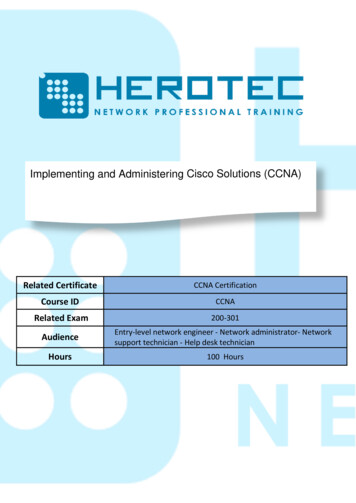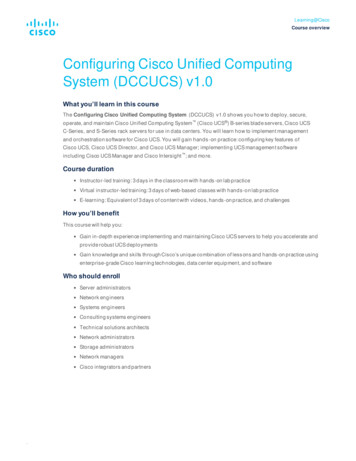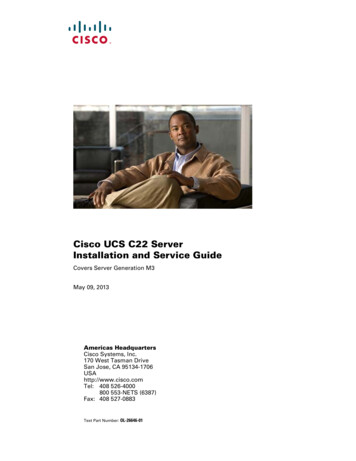
Transcription
Implementing and Administering Cisco Solutions (CCNA)Related CertificateCCNA CertificationCourse IDCCNARelated Exam200-301AudienceEntry-level network engineer - Network administrator- Networksupport technician - Help desk technicianHours100 Hours
Overview:New CCNA – 200-301Digital transformations - Multi-domain solutionsThe Implementing and Administering Cisco Solutions (CCNA) v1.0This Course covers a broad range of fundamentals based on the latest technologies, software developmentskills, and job roles, you will learn how to configure network components such as switches, routers, andwireless LAN controllers; managing network devices; and identifying basic security threats. The course alsogives you a foundation in network programmability, automation, and software-defined networking.When you finish this course you will be ready for the 200-301 CCNA examObjectives: Recognize components of a computer networkRecognize the model of host-to-host communicationDescribe the features and functions of the Cisco Internetwork Operating System (IOS ) softwareUnderstand LANs and the role of switches within LANsDescribe Ethernet as the network access layer of TCP/IP and describe the operation of switchesInstall a switch and perform the initial configurationDescribe the TCP/IP Internet layer, IPv4, its addressing scheme, and subnettingDescribe the TCP/IP Transport layer and Application layerRecognize functions of routingImplement basic configuration on a Cisco routerExplain host-to-host communications across switches and routersIdentify and resolve common switched network issues and common problems associated with IPv4addressingDescribe IPv6 main features and addresses, and configure and verify basic IPv6 connectivityDescribe the operation, benefits, and limitations of static routingDescribe, implement, and verify Virtual Local Area Networks (VLANs) and trunksDescribe the application and configuration of inter-VLAN routingExplain the basics of dynamic routing protocols and describe components and terms of Open ShortestPath First (OSPF)Explain how Spanning Tree Protocol (STP) and Rapid Spanning Tree Protocol (RSTP) workConfigure link aggregation using EtherChannelDescribe the purpose of Layer 3 redundancy protocolsDescribe basic WAN and VPN conceptsDescribe the operation of Access Control Lists (ACLs) and their applications in the network
Configure Internet access using Dynamic Host Configuration Protocol (DHCP) clients and explain andconfigure Network Address Translation (NAT) on Cisco routersDescribe basic Quality of Service (QoS) conceptsDescribe the concepts of wireless networks, which types of wireless networks can be built, and how touse Wireless LAN Controllers (WLCs)Describe network and device architectures and introduce virtualizationIntroduce the concept of network programmability and Software-Defined Networking (SDN) anddescribe smart network management solutions such as Cisco DNA Center , Software-Defined Access(SD-Access), and Software-Defined Wide Area Network (SD-WAN)Configure basic IOS system monitoring toolsDescribe the management of Cisco devicesDescribe the current security threat landscapeDescribe threat defense technologiesImplement a basic security configuration of the device management planeImplement basic steps to harden network devices.Course Outline: Implementing VLANs and TrunksRouting Between VLANsIntroducing OSPFBuilding Redundant Switched TopologiesImproving Redundant Switched Topologies with EtherChannelExploring Layer 3 RedundancyIntroducing WAN TechnologiesExplaining Basics of ACLEnabling Internet ConnectivityIntroducing QoSExplaining Wireless FundamentalsIntroducing Architectures and VirtualizationExplaining the Evolution of Intelligent NetworksIntroducing System MonitoringManaging Cisco DevicesExamining the Security Threat LandscapeImplementing Threat Defense TechnologiesSecuring Administrative AccessImplementing Device Hardening
Labs outline Get Started with Cisco Command-Line Interface (CLI) Observe How a Switch Operates Perform Basic Switch Configuration Implement the Initial Switch Configuration Inspect TCP/IP Applications Configure an Interface on a Cisco Router Configure and Verify Layer 2 Discovery Protocols Implement an Initial Router Configuration Configure Default Gateway Explore Packet Forwarding Troubleshoot Switch Media and Port Issues Troubleshoot Port Duplex Issues Configure Basic IPv6 Connectivity Configure and Verify IPv4 Static Routes Configure IPv6 Static Routes Implement IPv4 Static Routing Implement IPv6 Static Routing Configure VLAN and Trunk Troubleshoot VLANs and Trunk Configure a Router on a Stick Implement Multiple VLANs and Basic Routing Between the VLANs Configure and Verify Single-Area OSPF Configure and Verify EtherChannel Improve Redundant Switched Topologies with EtherChannel Configure and Verify IPv4 ACLs
Implement Numbered and Named IPv4 ACLs Configure a Provider-Assigned IPv4 Address Configure Static NAT Configure Dynamic NAT and Port Address Translation (PAT) Implement PAT Log into the WLC Monitor the WLC Configure a Dynamic (VLAN) Interface Configure a DHCP Scope Configure a WLAN Define a Remote Access Dial-In User Service (RADIUS) Server Explore Management Options Explore the Cisco DNA Center Configure and Verify NTP Configure System Message Logging Create the Cisco IOS Image Backup Upgrade Cisco IOS Image Configure WLAN Using Wi-Fi Protected Access 2 (WPA2) Pre-Shared Key (PSK) Using the GUI Secure Console and Remote Access Enable and Limit Remote Access Connectivity Secure Device Administrative Access Configure and Verify Port Security Implement Device Hardening
Contacts:Address:1 Zaker Hussien st, 7th area, Nasr City, Cairo, EgyptPhone Numbers:Landline: 202 26709916 - 202 26709961Fax: 202 26709957General:002 .netfor more www.herotec.net
New CCNA - 200-301 Digital transformations - Multi-domain solutions The Implementing and Administering Cisco Solutions (CCNA) v1.0 This Course covers a broad range of fundamentals based on the latest technologies, software development skills, and job roles, you will learn how to configure network components such as switches, routers, and










